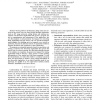89 search results - page 13 / 18 » Engineering self-coordinating software intensive systems |
COMPSAC
2008
IEEE
14 years 2 months ago
2008
IEEE
— In software testing and maintenance activities, the observed faults and bugs are reported in bug report managing systems (BRMS) for further analysis and repair. According to th...
BTLAB
1997
Springer
13 years 11 months ago
1997
Springer
Software agents help people with time consuming activities. One increasingly popular application for software agents is electronic commerce, namely having agents buy and sell good...
OOPSLA
2004
Springer
14 years 27 days ago
2004
Springer
Generics offer significant software engineering benefits since they provide code reuse without compromising type safety. Thus generics will be added to the Java language in the...
ISPASS
2010
IEEE
14 years 2 months ago
2010
IEEE
After many years of prefetching research, most commercially available systems support only two types of prefetching: software-directed prefetching and hardware-based prefetchers u...
WCRE
2010
IEEE
13 years 5 months ago
2010
IEEE
Abstract—During software development, design rules and contracts in the source code are often encoded through regularities, such as API usage protocols, coding idioms and naming ...

